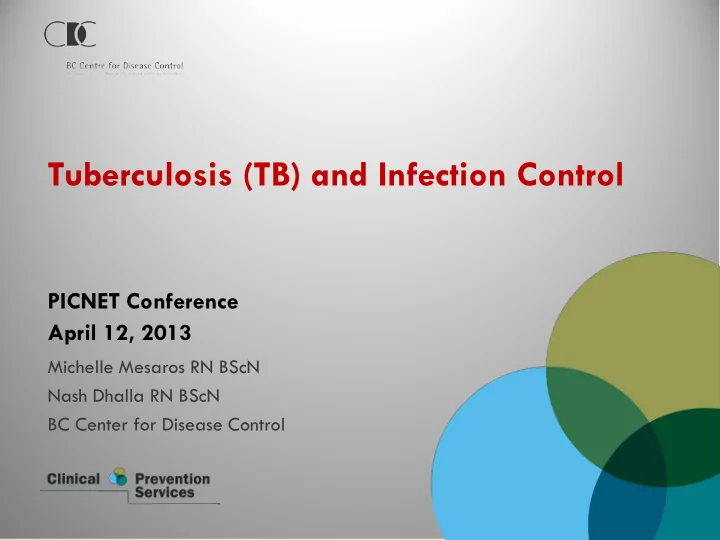

Tuberculosis (TB) and Infection Control PICNET Conference April 12, 2013 Michelle Mesaros RN BScN Nash Dhalla RN BScN BC Center for Disease Control
TB and Infection Control WHAT IS TB?
TB Statistics (2011) • Global: ~ 8 million new TB cases of TB disease each year • Canada: – 1772 new cases of TB disease – Incidence 4.7 cases per 100 000 population • BC: – 255 new cases of TB disease – Incidence 5.6 cases per 100 000 population – 6 th highest incidence rate of TB disease in Canada • Nunavut: – Incidence 222.1 cases per 100 000 population – Highest incidence rate of TB disease in Canada Note: 2011 data provisional until release of Tuberculosis in Canada, 2011 Source: Public Health Agency of Canada. Tuberculosis in Canada 2011 – Pre-Release. Ottawa (Canada): Minister of Public Works and Government Services Canada; 2012
What is TB? Tuberculosis (TB) is an infection caused by slow-growing bacteria that grow best in areas of the body that have an abundance of blood and oxygen. For that reason, TB disease is most often found in the lungs . TB disease in the lungs is called “pulmonary TB”. TB disease can also affect other parts of the body (extrapulmonary TB). Treatment for TB disease is usually curative, but can take 6 to 9 months (or longer) to complete.
Symptoms of Pulmonary TB • Cough (usually productive) • Coughing up blood (hemoptysis) • Excessive sweating, especially at night • Fatigue • Fever • Chest pain • Unexplained weight loss
Latent TB Infection (LTBI) In most cases, after TB germs enter the body, the immune system will put them into a dormant (latent) state. The immune system cannot kill TB germs; they can remain viable for years in a latent state. LTBI means TB germs are in the body but they are not active. While TB germs are latent, they do not cause damage, and they cannot be spread to others. People with LTBI do not have symptoms of TB disease. A positive TB skin test (TST) or IGRA is usually the only way to tell if a person has been infected with TB bacteria.
How is TB Diagnosis Made? • Pulmonary TB – confirmed by respiratory specimen (e.g., sputum) analysis – PCR probe or culture result • Extrapulmonary TB – (or non-respiratory) confirmed by tissue biopsy or body fluid analysis – PCR probe or culture result • Empiric treatment – physician determines constellation of TB history, symptoms, and/or presenting issues are consistent with TB disease; treatment is initiated without specimen to confirm diagnosis
Frequently Asked Questions • Is this patient still infectious? • Can we/should we discontinue isolation precautions? • This patient isn’t coughing and can’t produce sputum, what can we do? • What is the best way to organize a TST for an exposed inpatient? • This patient tells us he has a history of TB. Is TB Control aware of him? • This patient is going to be discharged soon. Does someone need to know? • This patient is still on isolation and wants to leave. What do I tell him? What do I tell the unit staff?
TB Control Would Like to See… Automatic sputum collection for newly diagnosed HIV • patients, newly diagnosed cancer patients – not done yet A call to New Westminster/Vancouver TB Clinic • supervisor when patient is ready for discharge (unit staff responsibility) – usually done HLTH 939s for all inpatients receiving a TST – rarely • done. Please send the top (white) copy On inpatient contact lists – specific mention of • extenuating medical conditions that compromise a patient’s immune system (e.g., extensive burns, cancer, HIV infection)
Case Scenario Discussion • AFB positive mycobacteria lab report • Patient is in a local hospital • Isolation recommendations pending PCR result • Presentation to hospital, admission, patient activity while in hospital • Positive PCR result • TB Control inpatient/healthcare worker exposure follow up recommendations • Inpatients exposed in emergency and ICU – hallmarks and locations
Case Scenario • What questions might you have for TB Control when you learn of this patient? • What do you think TB Control needs to know? • What actions should be taken with patients who have AFB positive mycobacteria lab results? (sputum, non-sputum) • Who requires notification of inpatients that were exposed? • Who else needs to be notified of TB exposure within a hospital or facility setting? • Do you know your recommendations notification channels? • Do you have any anecdotal questions?
What Can We Do For You?
Recommend
More recommend